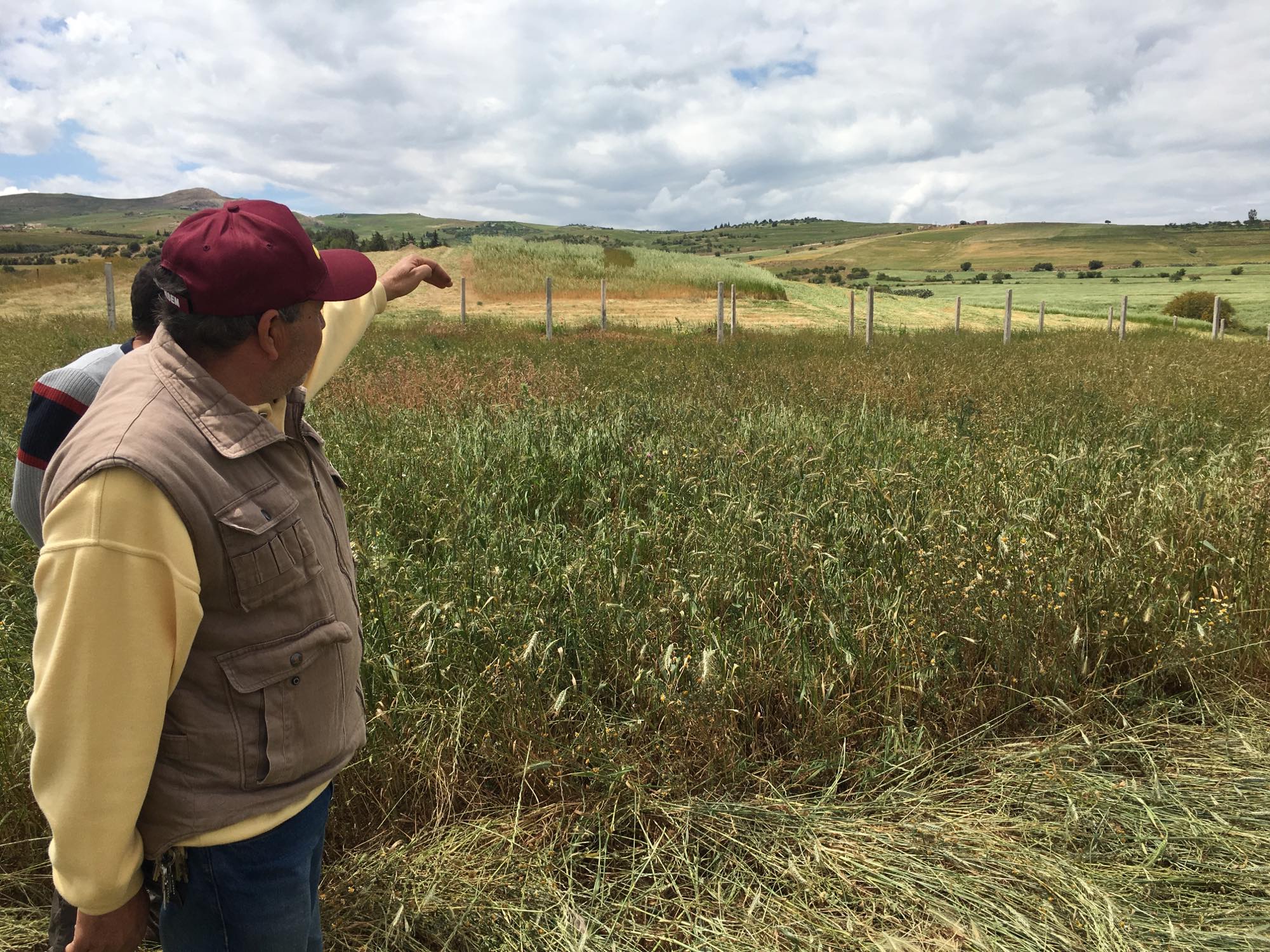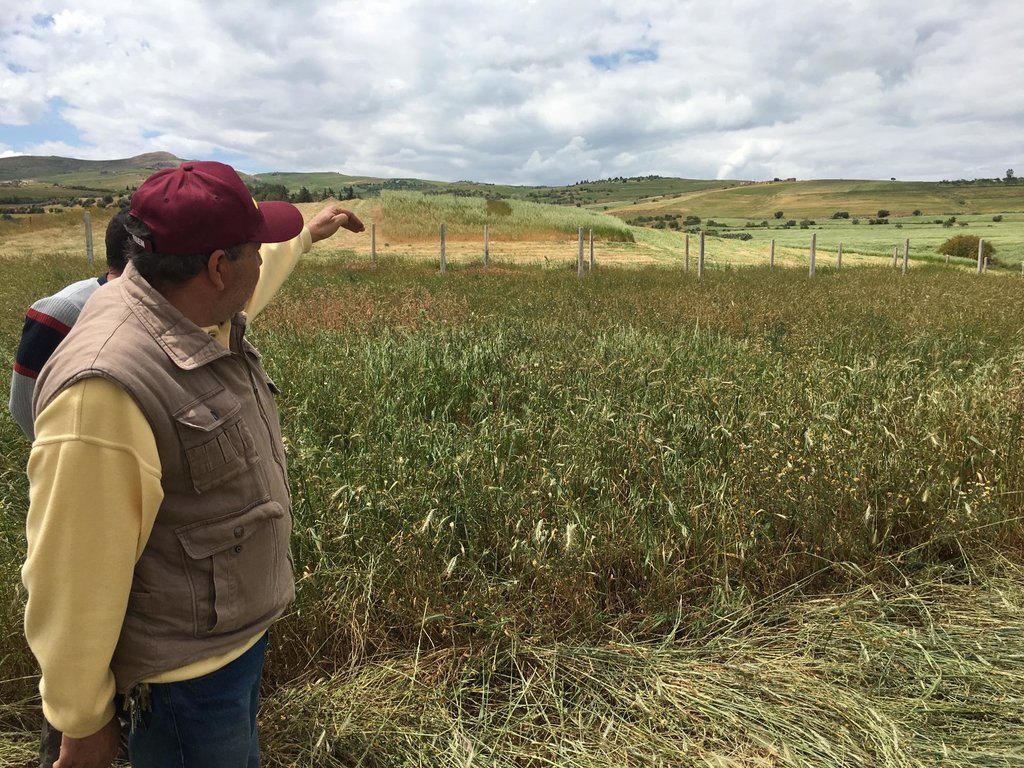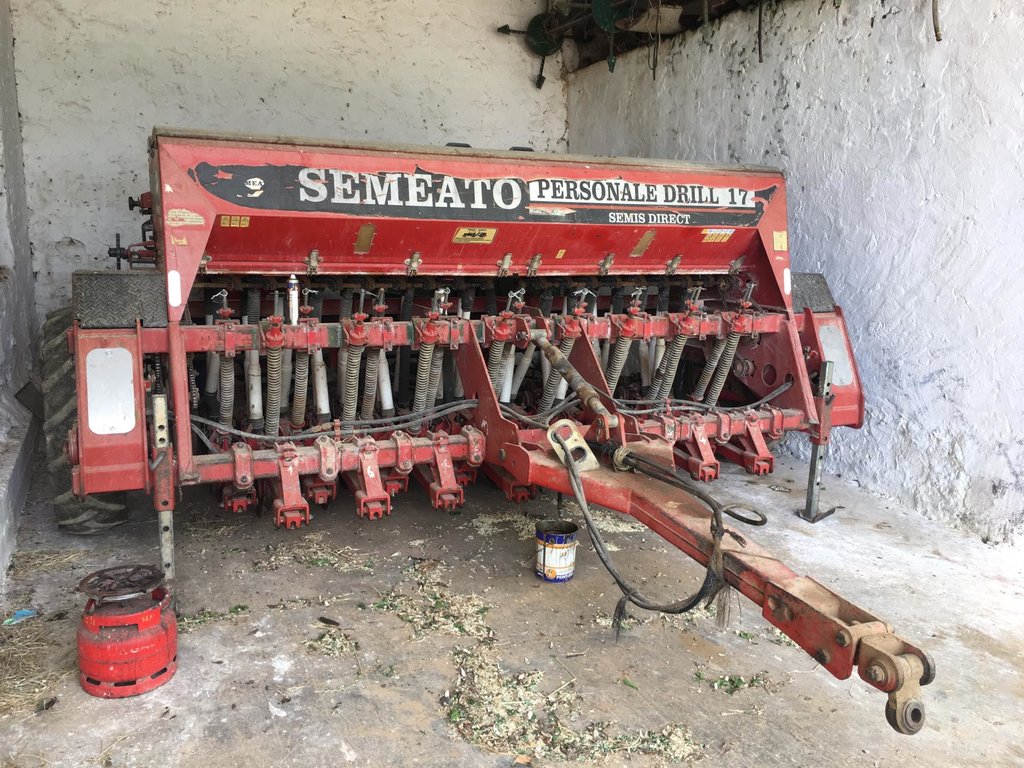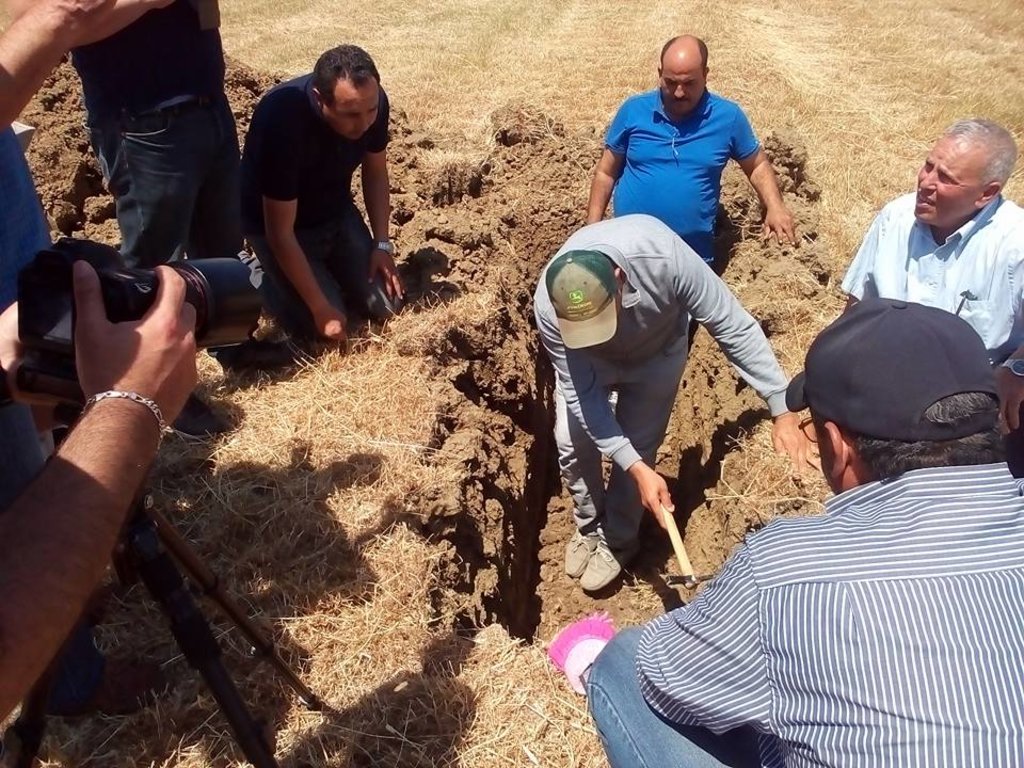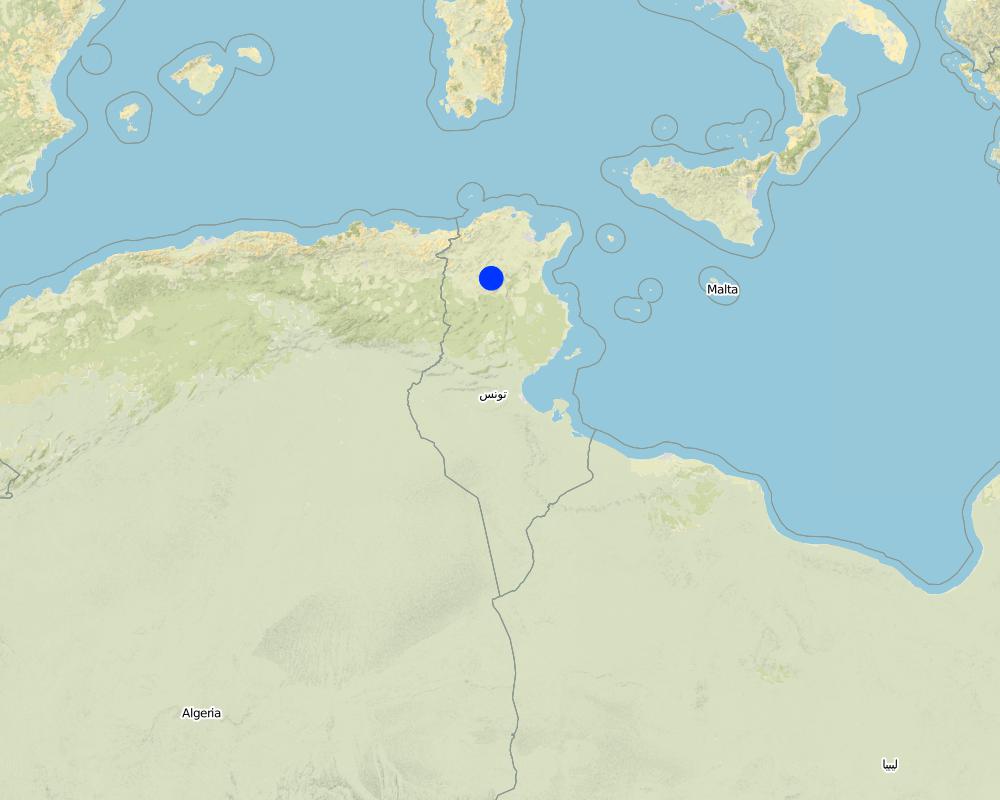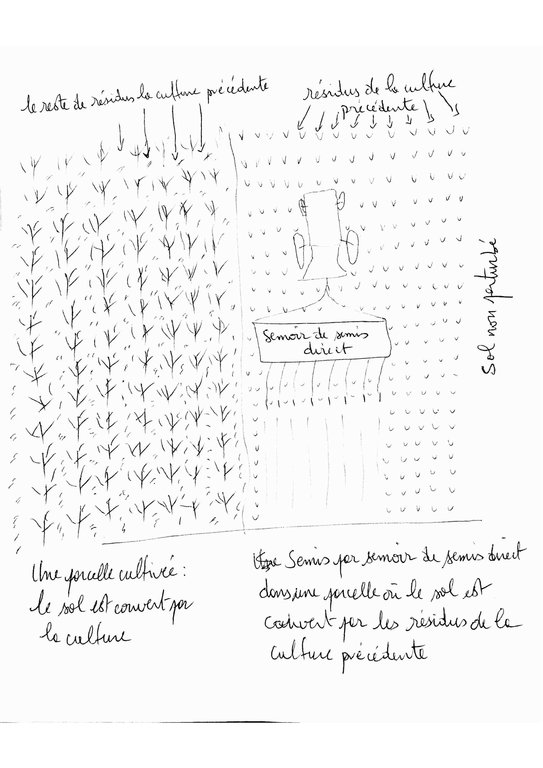Agriculture de Conservation [Tunisia]
- Creation:
- Update:
- Compiler: Donia Mühlematter
- Editors: Donia Mühlematter, Houcine Angar
- Reviewers: Donia Mühlematter, Alexandra Gavilano
Semis direct
technologies_3727 - Tunisia
View sections
Expand all Collapse all1. General information
1.2 Contact details of resource persons and institutions involved in the assessment and documentation of the Technology
Key resource person(s)
SLM specialist:
Angar Houcine
Institut National des Grandes Cultures
Tunisia
land user:
Abderabbou Adnen
Association d'Agriculture de Conservation
Tunisia
Name of project which facilitated the documentation/ evaluation of the Technology (if relevant)
Decision Support for Mainstreaming and Scaling out Sustainable Land Management (GEF-FAO / DS-SLM)Name of the institution(s) which facilitated the documentation/ evaluation of the Technology (if relevant)
Institut National des Grandes Cultures (INGC) - Tunisia1.3 Conditions regarding the use of data documented through WOCAT
The compiler and key resource person(s) accept the conditions regarding the use of data documented through WOCAT:
Yes
1.4 Declaration on sustainability of the described Technology
Is the Technology described here problematic with regard to land degradation, so that it cannot be declared a sustainable land management technology?
No
Comments:
Au contraire, l'agriculture de conservation favorise la limitation de dégradation des terres et améliore la production.
1.5 Reference to Questionnaire(s) on SLM Approaches (documented using WOCAT)
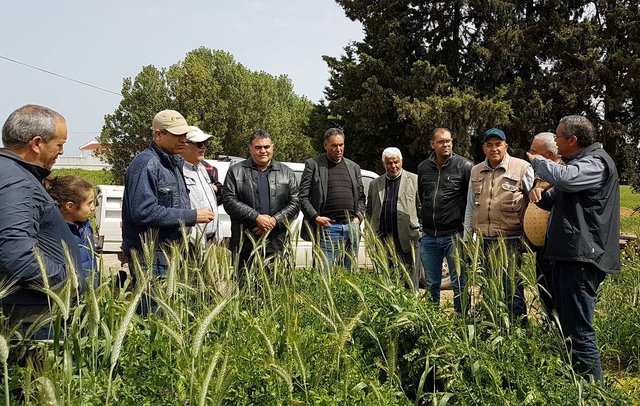
Un réseau informel pour l'implémentation de l'agriculture de … [Tunisia]
La création d'un réseau informel pour le développement des mesures de conservation des terres en agriculture de conservation.
- Compiler: Donia Mühlematter
2. Description of the SLM Technology
2.1 Short description of the Technology
Definition of the Technology:
L’agriculture de conservation est une technologie basée sur trois principes : la perturbation minimale du sol, la couverture permanente des sols et la diversification de cultures en rotations ou en séquences.
2.2 Detailed description of the Technology
Description:
Vu les problèmes de dégradation des terres par l’érosion hydrique et le baisse de la fertilité chimique et biologique des sols qui ont conduit à une diminution des rendements des grandes cultures, l’agriculture et lors d’une réunion avec les représentants du ministère de l’agriculture ou un groupe étranger a présenté l’agriculture de conservation comme alternative à la dégradation des terres et l’amélioration de sa fertilité, il s’est convaincu de l’utilité de cette technologie et il a testé l’application de l’agriculture de conservation avec ses trois principes dans ses terres avec l’appui d’un groupe d’experts français du CIRAD à travers l’agence française de développement AFD et le centre technique des céréales en Tunisie.
En faite l’agriculture de conservation consiste à éliminer le labour de la terre et le remplacer par un désherbage chimique pour éliminer les mauvaises herbes et de semer directement par un semoir spécial appelé semoir de semis direct. Ensuite l’agriculture conduit ses cultures comme il le faisait auparavant après récolte, l’agriculture doit laisser une partie des résidus des cultures sur le sol pour le couvrir durant l’été, la période ou il n’y a pas des cultures. L’agriculture de conservation exige aussi l’élimination de la monoculture et le diversification des cultures qu’on appelle rotation ou séquence des cultures des différentes familles.
2.3 Photos of the Technology
2.4 Videos of the Technology
Comments, short description:
Semis Direct sous couvert végétal vivant permanent.
2.5 Country/ region/ locations where the Technology has been applied and which are covered by this assessment
Country:
Tunisia
Region/ State/ Province:
Krib, Siliana
Specify the spread of the Technology:
- evenly spread over an area
If precise area is not known, indicate approximate area covered:
- 1-10 km2
Comments:
140 ha (98% de surface est cultivé)
Map
×2.6 Date of implementation
Indicate year of implementation:
1999
If precise year is not known, indicate approximate date:
- 10-50 years ago
2.7 Introduction of the Technology
Specify how the Technology was introduced:
- through land users' innovation
Comments (type of project, etc.):
Appui par l'Institut Nationale des Grandes Cultures (INGC).
3. Classification of the SLM Technology
3.1 Main purpose(s) of the Technology
- improve production
- reduce, prevent, restore land degradation
- conserve ecosystem
- protect a watershed/ downstream areas – in combination with other Technologies
- preserve/ improve biodiversity
- reduce risk of disasters
- adapt to climate change/ extremes and its impacts
- mitigate climate change and its impacts
- create beneficial economic impact
3.2 Current land use type(s) where the Technology is applied

Cropland
- Annual cropping
- Perennial (non-woody) cropping
Annual cropping - Specify crops:
- cereals - other
- vegetables - other
- Céréales, légumineuses alimentaires, fourragères, cultures industriels, et cultures pérennes.
Number of growing seasons per year:
- 2
Specify:
Fourrages d'été aprés foin.

Grazing land
Extensive grazing:
- Ranching
Intensive grazing/ fodder production:
- Cut-and-carry/ zero grazing
- Improved pastures
Animal type:
- cattle - dairy
- goats
- sheep
Species:
cattle - dairy
Count:
200
Species:
poultry
Count:
10
3.4 Water supply
Water supply for the land on which the Technology is applied:
- rainfed
3.5 SLM group to which the Technology belongs
- rotational systems (crop rotation, fallows, shifting cultivation)
- improved ground/ vegetation cover
- minimal soil disturbance
3.6 SLM measures comprising the Technology

agronomic measures
- A1: Vegetation/ soil cover
- A2: Organic matter/ soil fertility
- A3: Soil surface treatment
- A4: Subsurface treatment

vegetative measures
- V2: Grasses and perennial herbaceous plants
- V4: Replacement or removal of alien/ invasive species

management measures
- M2: Change of management/ intensity level
- M3: Layout according to natural and human environment
- M4: Major change in timing of activities
- M5: Control/ change of species composition
3.7 Main types of land degradation addressed by the Technology

soil erosion by water
- Wt: loss of topsoil/ surface erosion
- Wg: gully erosion/ gullying
- Wm: mass movements/ landslides
- Wr: riverbank erosion
- Wo: offsite degradation effects

soil erosion by wind
- Et: loss of topsoil
- Ed: deflation and deposition
- Eo: offsite degradation effects

chemical soil deterioration
- Cn: fertility decline and reduced organic matter content (not caused by erosion)

physical soil deterioration
- Pc: compaction
- Pk: slaking and crusting
- Pi: soil sealing
- Pw: waterlogging
- Ps: subsidence of organic soils, settling of soil
- Pu: loss of bio-productive function due to other activities

biological degradation
- Bc: reduction of vegetation cover
- Bh: loss of habitats
- Bq: quantity/ biomass decline
- Bf: detrimental effects of fires
- Bs: quality and species composition/ diversity decline
- Bl: loss of soil life
- Bp: increase of pests/ diseases, loss of predators

water degradation
- Ha: aridification
- Hs: change in quantity of surface water
- Hg: change in groundwater/aquifer level
- Hp: decline of surface water quality
- Hq: decline of groundwater quality
- Hw: reduction of the buffering capacity of wetland areas
3.8 Prevention, reduction, or restoration of land degradation
Specify the goal of the Technology with regard to land degradation:
- prevent land degradation
- reduce land degradation
4. Technical specifications, implementation activities, inputs, and costs
4.1 Technical drawing of the Technology
Technical specifications (related to technical drawing):
Le dessin technique montre une partie de la parcelle qui est cultivée, dont le sol est couvert par les cultures. Une deuxième partie est parcouru par le semoir de semis direct, dont le sol est couvert par les résidues de la culture précédente.
Author:
Houcine Angar
Date:
30/04/2018
4.2 General information regarding the calculation of inputs and costs
Specify how costs and inputs were calculated:
- per Technology area
Indicate size and area unit:
1 hectare
other/ national currency (specify):
Dinar Tunisien
If relevant, indicate exchange rate from USD to local currency (e.g. 1 USD = 79.9 Brazilian Real): 1 USD =:
2.5
Indicate average wage cost of hired labour per day:
20 Dinar Tunisien.
4.3 Establishment activities
| Activity | Timing (season) | |
|---|---|---|
| 1. | Désherbage chimique au lieu du labour | Novembre |
| 2. | Semis direct | Novembre |
| 3. | Premier apport de fertilisation azotée | Décembre |
| 4. | Désherbage chimique | Janvier |
| 5. | Deuxième apport de fertilisation azotée | Mars |
4.4 Costs and inputs needed for establishment
| Specify input | Unit | Quantity | Costs per Unit | Total costs per input | % of costs borne by land users | |
|---|---|---|---|---|---|---|
| Labour | ouvriers | personne/jour | 2.0 | 8.0 | 16.0 | 100.0 |
| Equipment | location tracteur | heure | 6.0 | 18.0 | 108.0 | 100.0 |
| Equipment | location semoir | heure | 1.0 | 45.0 | 45.0 | 100.0 |
| Equipment | location moisonneuse | heure | 1.25 | 30.0 | 37.5 | 100.0 |
| Equipment | location presse paille | balle | 120.0 | 0.4 | 48.0 | 100.0 |
| Plant material | semences | quintal | 1.7 | 60.0 | 102.0 | 100.0 |
| Fertilizers and biocides | herbicides | litre | 3.0 | 20.0 | 60.0 | 100.0 |
| Fertilizers and biocides | fertilisation azotée | quintal | 2.5 | 22.0 | 55.0 | 100.0 |
| Total costs for establishment of the Technology | 471.5 | |||||
| Total costs for establishment of the Technology in USD | 188.6 | |||||
Comments:
Le coût par unité est relatif à l'année 1999, mais actuellement il s'et augmenté de 70% à peu prés.
4.5 Maintenance/ recurrent activities
Comments:
Pas des activités spécifiques pour entretenir cette technologie. Se sont les meme que les activités de mise en place.
4.6 Costs and inputs needed for maintenance/ recurrent activities (per year)
Comments:
Pas des activités spécifiques pour entretenir cette technologie. Se sont les meme que les activités de mise en place.
4.7 Most important factors affecting the costs
Describe the most determinate factors affecting the costs:
L'augmentation des prix des intrants.
5. Natural and human environment
5.1 Climate
Annual rainfall
- < 250 mm
- 251-500 mm
- 501-750 mm
- 751-1,000 mm
- 1,001-1,500 mm
- 1,501-2,000 mm
- 2,001-3,000 mm
- 3,001-4,000 mm
- > 4,000 mm
Specify average annual rainfall (if known), in mm:
450.00
Indicate the name of the reference meteorological station considered:
Station propre à l'exploitant.
Agro-climatic zone
- semi-arid
Semi aride supérieur.
5.2 Topography
Slopes on average:
- flat (0-2%)
- gentle (3-5%)
- moderate (6-10%)
- rolling (11-15%)
- hilly (16-30%)
- steep (31-60%)
- very steep (>60%)
Landforms:
- plateau/plains
- ridges
- mountain slopes
- hill slopes
- footslopes
- valley floors
Altitudinal zone:
- 0-100 m a.s.l.
- 101-500 m a.s.l.
- 501-1,000 m a.s.l.
- 1,001-1,500 m a.s.l.
- 1,501-2,000 m a.s.l.
- 2,001-2,500 m a.s.l.
- 2,501-3,000 m a.s.l.
- 3,001-4,000 m a.s.l.
- > 4,000 m a.s.l.
Indicate if the Technology is specifically applied in:
- convex situations
5.3 Soils
Soil depth on average:
- very shallow (0-20 cm)
- shallow (21-50 cm)
- moderately deep (51-80 cm)
- deep (81-120 cm)
- very deep (> 120 cm)
Soil texture (topsoil):
- medium (loamy, silty)
Soil texture (> 20 cm below surface):
- medium (loamy, silty)
Topsoil organic matter:
- low (<1%)
5.4 Water availability and quality
Ground water table:
on surface
Availability of surface water:
medium
Water quality (untreated):
good drinking water
Is water salinity a problem?
No
Is flooding of the area occurring?
No
5.5 Biodiversity
Species diversity:
- high
Habitat diversity:
- high
5.6 Characteristics of land users applying the Technology
Sedentary or nomadic:
- Sedentary
Market orientation of production system:
- mixed (subsistence/ commercial)
Off-farm income:
- less than 10% of all income
Relative level of wealth:
- rich
Individuals or groups:
- groups/ community
Level of mechanization:
- mechanized/ motorized
Gender:
- men
Age of land users:
- middle-aged
Indicate other relevant characteristics of the land users:
L'exploitant est bien éduqué.
5.7 Average area of land used by land users applying the Technology
- < 0.5 ha
- 0.5-1 ha
- 1-2 ha
- 2-5 ha
- 5-15 ha
- 15-50 ha
- 50-100 ha
- 100-500 ha
- 500-1,000 ha
- 1,000-10,000 ha
- > 10,000 ha
Is this considered small-, medium- or large-scale (referring to local context)?
- large-scale
Comments:
140 ha en Agriculture de Conservation.
5.8 Land ownership, land use rights, and water use rights
Land ownership:
- individual, titled
Land use rights:
- individual
Water use rights:
- individual
5.9 Access to services and infrastructure
health:
- poor
- moderate
- good
education:
- poor
- moderate
- good
technical assistance:
- poor
- moderate
- good
employment (e.g. off-farm):
- poor
- moderate
- good
markets:
- poor
- moderate
- good
energy:
- poor
- moderate
- good
roads and transport:
- poor
- moderate
- good
drinking water and sanitation:
- poor
- moderate
- good
financial services:
- poor
- moderate
- good
6. Impacts and concluding statements
6.1 On-site impacts the Technology has shown
Socio-economic impacts
Production
crop production
crop quality
fodder production
fodder quality
animal production
risk of production failure
product diversity
production area
land management
Income and costs
expenses on agricultural inputs
farm income
diversity of income sources
economic disparities
workload
Socio-cultural impacts
food security/ self-sufficiency
health situation
cultural opportunities
recreational opportunities
community institutions
national institutions
SLM/ land degradation knowledge
situation of socially and economically disadvantaged groups
Ecological impacts
Water cycle/ runoff
water quantity
water quality
harvesting/ collection of water
surface runoff
excess water drainage
groundwater table/ aquifer
evaporation
Soil
soil moisture
soil cover
soil loss
soil accumulation
soil crusting/ sealing
soil compaction
nutrient cycling/ recharge
soil organic matter/ below ground C
acidity
Biodiversity: vegetation, animals
Vegetation cover
biomass/ above ground C
plant diversity
invasive alien species
animal diversity
beneficial species
habitat diversity
pest/ disease control
Climate and disaster risk reduction
flood impacts
landslides/ debris flows
drought impacts
impacts of cyclones, rain storms
emission of carbon and greenhouse gases
fire risk
wind velocity
micro-climate
6.2 Off-site impacts the Technology has shown
downstream flooding
downstream siltation
groundwater/ river pollution
buffering/ filtering capacity
wind transported sediments
damage on neighbours' fields
damage on public/ private infrastructure
impact of greenhouse gases
6.3 Exposure and sensitivity of the Technology to gradual climate change and climate-related extremes/ disasters (as perceived by land users)
Gradual climate change
Gradual climate change
| Season | increase or decrease | How does the Technology cope with it? | |
|---|---|---|---|
| annual temperature | increase | well | |
| seasonal temperature | dry season | increase | well |
| annual rainfall | decrease | well | |
| seasonal rainfall | wet/ rainy season | decrease | well |
Climate-related extremes (disasters)
Meteorological disasters
| How does the Technology cope with it? | |
|---|---|
| local rainstorm | well |
| local thunderstorm | well |
Climatological disasters
| How does the Technology cope with it? | |
|---|---|
| heatwave | well |
| cold wave | well |
| extreme winter conditions | well |
| drought | very well |
| land fire | moderately |
Hydrological disasters
| How does the Technology cope with it? | |
|---|---|
| landslide | very well |
Biological disasters
| How does the Technology cope with it? | |
|---|---|
| epidemic diseases | very well |
| insect/ worm infestation | very well |
Other climate-related consequences
Other climate-related consequences
| How does the Technology cope with it? | |
|---|---|
| extended growing period | well |
| reduced growing period | moderately |
6.4 Cost-benefit analysis
How do the benefits compare with the establishment costs (from land users’ perspective)?
Short-term returns:
positive
Long-term returns:
very positive
How do the benefits compare with the maintenance/ recurrent costs (from land users' perspective)?
Short-term returns:
very positive
Long-term returns:
very positive
6.5 Adoption of the Technology
- 1-10%
If available, quantify (no. of households and/ or area covered):
12000 ha
Of all those who have adopted the Technology, how many did so spontaneously, i.e. without receiving any material incentives/ payments?
- 0-10%
6.6 Adaptation
Has the Technology been modified recently to adapt to changing conditions?
Yes
other (specify):
la dégradation du mulch nécessite plus d'azote.
6.7 Strengths/ advantages/ opportunities of the Technology
| Strengths/ advantages/ opportunities in the land user’s view |
|---|
| Conservation et amélioration de la fertilité et propriétés physico-chimiques et biologiques du sol. |
| Stabilisation des rendements des cultures. |
| Améliorer la biodiversité végétale et animale. |
| Diminuer la pollution des nappes souterraines. |
| Coservation de l'eau dans le sol. |
| Strengths/ advantages/ opportunities in the compiler’s or other key resource person’s view |
|---|
| Conservation du sol contre l'érosion hydrique et amélioration de sa fertilité et propriétés physico-chimique et biologique du sol. |
| Réduction des couts de production des cultures. |
| Amélioration de la marge brute. |
| Séquestration du carbonne dans le sol. |
| Réduction de l'utilisation de l'énergie. |
6.8 Weaknesses/ disadvantages/ risks of the Technology and ways of overcoming them
| Weaknesses/ disadvantages/ risks in the land user’s view | How can they be overcome? |
|---|---|
| L'utilisation d'un herbicide total (gluphosate). | Remplacement de l'herbicide par un désherbage mécanique par les rouleaux ou le paturage. |
| Cout de semoir de semis direct pour les petits agriculteurs. | Subvention spécial pour l'achat de semoir et association des agriculteurs pour l'utilisation en commun de semoir. |
| Pas de législation qui encourage l'adoption. | Octroi des subventions et encouragements. |
| Manque de vulgarisation et sensibilsation. | Plus de sensibilisation et de vulgarisation pour accompagner les agriculteurs. |
| Weaknesses/ disadvantages/ risks in the compiler’s or other key resource person’s view | How can they be overcome? |
|---|---|
| Nécissité d'une bonne technicitö de la part des agriculteurs. | Il faut accompagner techniquement les agriculteurs désireux d'adopter cette technologie. |
| Faiblement adoptö en Tunisie. | Il faut beaucoup du travail pour étendre cette bonne pratique et il faut6 établir une stratögie national pour le développement de l'agriculture de conservation. |
7. References and links
7.1 Methods/ sources of information
- field visits, field surveys
8 Agricultures des différents régions.
- interviews with land users
8 Agricultures des différents régions.
- interviews with SLM specialists/ experts
1 expert agronome.
7.3 Links to relevant online information
Title/ description:
Adoption of Conservation Agriculture in Tunisia: Approches and Strategies Implemented
URL:
http://www.ctic.org/media/pdf/WCCA/01_Houcine%20Angar(1).pdf
Title/ description:
Agriculture de Conservation : Concilier adaptation et mitigation pour une intensification durable des systèmes agricoles méditerranéens
URL:
http://www.ipemed.coop/adminIpemed/media/fich_article/1469717998_pwp-atelier-5-medcop-climatmrabet-inra.pdf
Links and modules
Expand all Collapse allLinks

Un réseau informel pour l'implémentation de l'agriculture de … [Tunisia]
La création d'un réseau informel pour le développement des mesures de conservation des terres en agriculture de conservation.
- Compiler: Donia Mühlematter
Modules
No modules


